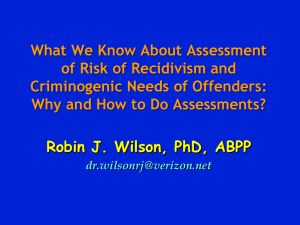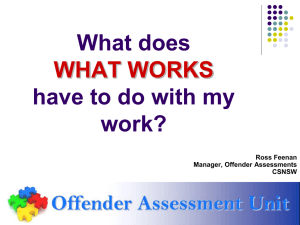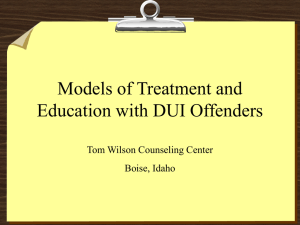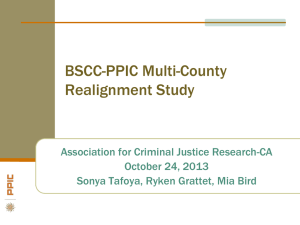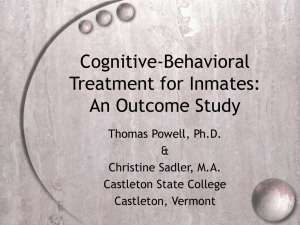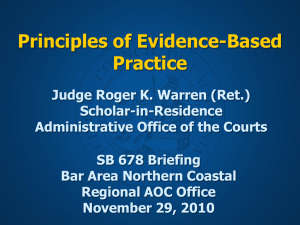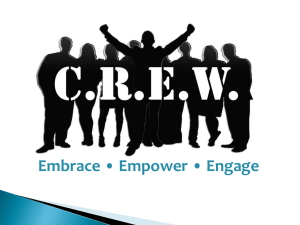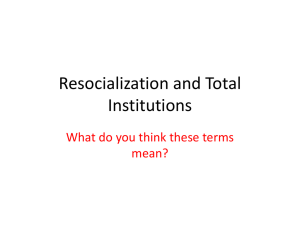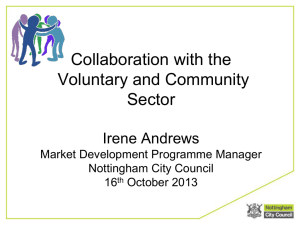RNR Tool for Reentry
advertisement
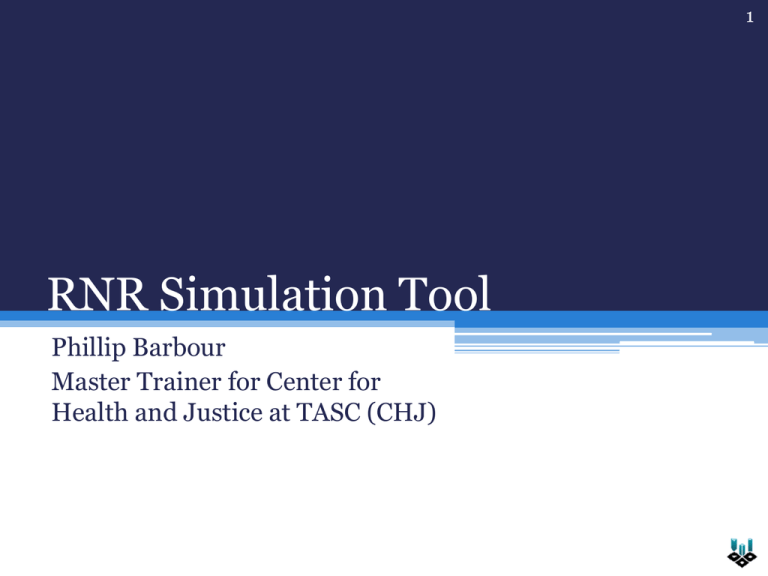
1 RNR Simulation Tool Phillip Barbour Master Trainer for Center for Health and Justice at TASC (CHJ) 2 Risk, Needs, Responsivity (RNR) and Recidivism: An Update on Theory Center for Advancing Correctional Excellence (ACE!) George Mason University www.gmuace.org/tools BJA: 2009-DG-BX-K026; BJA: 2010-DG-BX-K077; SAMHSA: 202171; Public Welfare Foundation 3 Faye S. Taxman, Ph.D University Professor Center for Advancing Correctional Excellence Criminology, Law and Society George Mason University 10519 Braddock Road Suite 1900 Fairfax, VA 22032 James M. Byrne, Ph.D. Professor University of Massachusetts, Lowell Griffith University April Pattavina, Ph.D. Discrete Event Model Associate Professor University of Massachusetts, Lowell Avinash Singh Bhati, Ph.D. Simulation Model Maxarth, LLC Michael S. Caudy, Ph.D. Stephanie A. Maass, M.A. Erin L. Crites, M.A. Lauren Duhaime, B.A. Amy Murphy, MPP Joseph Durso, M.A. Gina Rosch Special Acknowledgements: • Bureau of Justice Assistance ▫ BJA: 2009-DG-BX-K026 • Center for Substance Abuse Treatment ▫ SAMHSA: 202171 • Public Welfare Foundation • Special Thanks to: ▫ Ed Banks, Ph.D. ▫ Ken Robertson 4 What affects recidivism? The good, the bad, and the ugly! Understand Risk Understand What Affects Recidivism 5 67% Reducing Recidivism: The RNR Framework Target individual risk Target needs that are amendable to change Offer quality programs Engage offenders in change process 6 What is Risk? • Risk is the likelihood that an offender will engage in future criminal behavior (recidivate). • Risk does NOT refer to dangerousness or likelihood of violence • Static Risk Factors have a demonstrated correlation with criminal behavior ▫ Historical – based on criminal history ▫ Cannot be decreased by intervention 7 CJ Risk Matters…(3 year, all offenses) Risk is static factors: history of arrests, age of onset, history of incarceration, history of escapes, etc. Ainsworth, Crites, Caudy, & Taxman, 2011 8 Age & Rearrests Langan & Levin, 2002 9 Gender Matters Ainsworth, et al 2011 10 Evidence-Based Practices Lead to Better Outcomes • Education (Psycho-Social) • Non-Directive Counseling • Directive Counseling • • • • Motivational Interviewing Moral Reasoning Emotional Skills 12 Step with Curriculum • Cognitive Processing • Cognitive Behavioral (Social Skills, Behavioral Management, etc.) • Therapeutic Communities (TC) • Contingency Management/Token Economies • • • • Intensive Supervision Boot Camp Case Management Incarceration • TASC • DTAP (Diversion to TX, 12 Month Residential) • Treatment with Sanctions (e.g. Break the Cycle, Seamless System, etc.) • Drug Courts • RNR Supervision • In-Prison TC with Aftercare 11 Better Outcomes via Tx Matching Caudy, et al (2011). Using Data to Examine Outcomes: A review of Kansas Department of Corrections. Fairfax, VA: George Mason University. 12 http://www.gmuace.org/tools/ 13 The RNR Simulation Tool • Provide decision support tools for the field that enhance existing practices ▫ Individual level ▫ Program feedback ▫ System building capability • Program Tool focuses on: ▫ Classifying programs to target specific needs ▫ Rating key program features ▫ Linking to meta-analyses/systematic reviews Compiled National Database (20,000+) or Develop Your Own Database Race White White White White White White White White White White White White White White White White White White White White White White White White … Black Black Black Black … Other … • • • • Gender Male Male Male Male Male Male Male Male Male Male Male Male Female Female Female Female Female Female Female Female Female Female Female Female … Male Male Male Male … … … Age 16-27 16-27 16-27 16-27 16-27 16-27 28-35 28-36 28-37 28-38 28-39 28-40 16-27 16-27 16-27 16-27 16-27 16-27 28-35 28-36 28-37 28-38 28-39 28-40 … 16-27 16-27 16-27 16-27 … … … Risk High High Medium Medium Low Low High High Medium Medium Low Low High High Medium Medium Low Low High High Medium Medium Low Low … High High Medium Medium … … … … … … … … … … … … … … … … … … … … … … … … … … … … … … … … … … … … Recidivism Recidivist Non-Recidivist Recidivist Non-Recidivist Recidivist Non-Recidivist Recidivist Non-Recidivist Recidivist Non-Recidivist Recidivist Non-Recidivist Recidivist Non-Recidivist Recidivist Non-Recidivist Recidivist Non-Recidivist Recidivist Non-Recidivist Recidivist Non-Recidivist Recidivist Non-Recidivist … Recidivist Non-Recidivist Recidivist Non-Recidivist … … … Placement Option 1 Placement Option 2 Placement Option 3 Prevalence Implication Prevalence Implication Prevalence Implication Prevalence Implication 630 74% 595 70% 610 72% 623 73% 220 255 240 227 240 65% 130 … … … … … … … … 35 60% 23 … … … … … … … … … … … … … … … … … … Base Recidivism Rate Risk & Need Information Destabilizers—performance inhibitors Programs Expected outcomes Reflect Expected Reductions in Recidivism (from Meta-Analysis) 15 Model to Improve Outcomes: Big Picture • Current recidivism hovers around 67% ▫ 3 year re-arrest rate • How can we make a dent in this at the system and individual level? Offender Individual Risk & Need Factors Program Quality Implementation Organizational Culture Correctional Programming Individual Outcomes (Reduced Recidivism) Focus of EBP Research Focus of RNR & RNR Simulation Tool 16 17 RNR via Andrews & Bonta Andrews & Bonta Updated research • • • • • • Responsivity, Recidivism, & Clinical Relevance Substance dependence vs. abuse Spectrum of needs can override risk (3+) Change is a function of problem severity History of antisocial behavior is risk (cannot be changed) Recidivism reduction is function of targeting specific needs within programs Antisocial personality patterns History of antisocial behavior Antisocial peers Antisocial attitudes Family/marital factors Employment/educational deficits • Lack of prosocial leisure activities • Substance Abuse 18 Major Criminogenic Needs • Severe Substance Use Disorders ▫ A pattern of harmful use of any substance for mood-altering purposes ▫ Includes 6 or more of the following: Increased tolerance, withdrawal, increased time spent using, difficulty quitting or cutting back, or continued use despite negative consequences ▫ Not the same as substance abuse ▫ Drug of choice matters 19 Major Criminogenic Needs • Criminal Thinking/Lifestyle ▫ A pattern of thinking that rationalizes and supports criminal behavior ▫ Involvement with criminal lifestyle ▫ Should be assessed using a validated instrument 20 What is Responsivity? • Treatment to address criminal behavior should be cognitive and/or behavioral based programming that has been shown to effectively reduce recidivism. • Deliver controls and treatment in a manner that is consistent with individuals’ learning styles ▫ Considers age, gender, culture, intelligence, motivation, etc. ▫ Translate Risk & Need into Program Placement/Case Decisions ▫ Needs trump risk when there is 3+ needs ▫ Destabilizers require more social controls 21 CJ RISK Criminogenic Needs Substance Tolerance for “Hard Drugs” 3+ Criminal Lifestyle—attitudes, family, peers, personality, substance abuse Stabilizers Supportive Family Stable Employment Education > HS Diploma Stable Housing Location in non-Hot Spots Destabilizers Alcohol Abuse Drug Abuse Family Dysfunction Poor Mental Health Status Employment-Related Issues Literacy Related Problems Housing Instability Location in Hot Spots Gender & Age 22 What Information do I Need? • Static Risk ▫ From a validated risk assessment tool ▫ Based on criminal history ▫ Demographics ▫ Age and gender ▫ Criminogenic Needs ▫ Substance Use ▫ Criminal thinking/lifestyle • Stabilizers and Destabilizers ▫ Clinically-relevant factors 23 The RNR Program Tool for Adults Define target behaviors that drive program classification Understand program group classification system 24 25 Program Groups • Six program groups based on specific target behaviors Risk Type of Need Type of Stabilizers PROGRAM GROUP MECHANISM OF ACTION RESEARCH EVIDENCE Group A Severe Substance Use/Dependence Treatments to reduce use of heroin, cocaine, amphetamines, and methamphetamine Holloway, Bennett, & Farrington, 2006; Prendergast, Huang, & Hser, 2008; Prendergast, Podus, Chang & Urada, 2002; Lipton, Pearson, Cleland & Yee, 2008; Mitchell, Wilson & MacKenzie, 2007 Group B Criminal Thinking Cognitive restructuring to change maladaptive thinking and behavior patterns Andrews & Bonta, 2010; Lipsey, Landenberger & Wilson, 2007; Wilson, Bouffard & MacKenzie, 2005; Little, 2005; Tong & Farrington, 2006 & 2008 Group C Self-Improvement and Management Developing social and problem solving skills to address MH, SA, and self-control. Botvin & Wills, 1984; Botvin, Griffin, & Nichols, 2006; Martin, Dorken, Wamboldt & Wootten, 2011 Group D Structured counseling and Social and modeling of behavior to reduce Interpersonal Skills interpersonal conflict and develop more positive interactions. Botvin & Wills, 1984; Beckmeyer, 2006; Wilson, Gallagher & MacKenzie, 2000; Visher, Winterfield & Coggeshall, 2005 Group E Life Skills Andrews & Bonta, 2010; Beckmeyer, 2006 Stabilize education, housing, employment, and financial concerns. 27 Program Groups for SUD Treatment • Offenders with SUDs have unique Tx needs ▫ Program Group A: Addicts ▫ Program Group C: Abusers with Lifestyle Factors • Operationalized essential features ▫ Program content, dosage, implementation fidelity • Example: Group A – most intensive ▫ Individual profile: all CJ risk levels; dependence on hard drugs; multiple criminogenic needs and destabilizers ▫ Program profile: cognitive restructuring techniques; adequate dosage to address high SUD need; clinical staff; evidence-based curricula; medication-assisted treatment 28 Essential Features of Effective Programs 29 Principles of Effective Interventions • Rehabilitative efforts have a greater impact on recidivism • There is no magic program ▫ There is no one program or program type identified that will consistently have a large impact on recidivism • We do know something about common features of effective correctional practice ▫ What really works? McGuire, 2002; Lipsey & Cullen, 2007 30 Program Quality Matters • Most programs score < 50% (unsatisfactory) • Program quality (Implementation, Risk-Need Assessment, Orientation) related to Recidivism Lowenkamp, Latessa, & Smith, 2006; see also Nesovic, 2003 31 Program Tool Factors • • • • Target Population Program Goals Program Theory Client Level Factors ▫ Spectrum of Needs/Severity of Program Needs ▫ Developmental Factors (e.g., age, gender, cognitive, physical) • Program Structure • Program Dosage (a lot unknown, clinical literature) • Implementation Issues ▫ Staffing ▫ Fidelity Monitoring, Training ▫ Quality Assurance 32 Substance Abuse Treatment Program 33 • Key Items: Use of a validated risk assessment and focus on appropriate risk levels • Justification: ▫ Use of a validated risk assessment is associated with more effective programs (Smith, Gendreau, Swartz, 2008) ▫ Provide more intensive services to higher risk individuals (Lowenkamp, Latessa, and Holsinger, 2006; Andrews & Dowden, 2006) 34 • Key Items: Program focuses on a primary target; uses appropriate content based on the target • Justification: ▫ Focus on criminogenic needs (Andrews, Bonta, and Hoge, 1990) ▫ Focus on stabilizers and destabilizers (Ward & Stewart, 2003) ▫ Treatment is theoretically linked to changes in the target (Cordray & Pion, 2006) 35 • Key Items: Program content with better evidence, use of rewards and sanctions, and addresses specific responsivity factors; ▫ Focus is on treatment matching • Justification: ▫ Programs more effective if consistent with an individual’s learning style Andrews, Zinger, et al., 1990a; Smith et al., 2009; Taxman, & Marlowe, Douglas, 2006 ▫ Treatment matching improves outcomes Mee-Lee, Shulman, Fishman, Gastfriend, & Griffith, 2001; Thornton, Gottheil, Weinstein & Kerachsky, 1998; Gastfriend & McLellan, 1997; Barbor, 2008 36 • Key Items: completion criteria, appropriate administration based on target, appropriate staff credentials based on target, staff communication, program evaluation, use of a treatment manual, coaching, technical assistance, quality assurance protocols • Justification: ▫ Implementation fidelity related to effectiveness Landenberger & Lipsey, 2005; Andrews & Dowden, 2005; McGrew, Bond, Dietzen & Salyers, 1994; Stanard, 1999; Simons, Padesky, Montemarano, Lewis, Murakami, Lamb et al., 2010; Taxman & Bouffard, 2000; Fletcher, et al., 2009; Taxman & Belenko, 2012 37 • Key Items: appropriate clinical hours, sufficient duration based on target, sufficient intensity based on target, sufficient frequency based on target, phases, and aftercare • Justification: ▫ Dosage positively related to effect size (Landenberger & Lipsey, 2005) ▫ High risk approximately 300 hours of CBT (Bourgon & Armstrong) ▫ Higher risk saw recidivism reduction with more dosage in drug treatment (Taxman, Byrne, & Thanner, 2002; Lowenkamp & Latessa, 2005) 38 • Key Items: Social controls in programs are also useful to enhance the impact of the content and dosage of programs • Justification: ▫ Increasing social controls for higher risk individuals can improve outcomes (Drake, Aos, & Miller, 2009; Padgett, Bales, and Blomberg, 2006; Pattavina, Tusinski-Miofsky, & Byrne, 2009) 39 Example Scores Domain Max Score MAT Drug Tx Center Re-entry Program Drug Court Outpatient Tx PROGRAM GROUP A A B A B Risk 15 0 0 15 15 5 Need 15 10 10 15 15 15 Responsivity 15 13 10 15 13 13 Implementation 25 17 18 21 21 21 Dosage 20 7 9 9 18 10 Restrictiveness 10 10 6 4 8 5 100 60 53 79 90 69 Total Score 40 New! Specialty Court Output 41 42 43 Building a Responsive System Identify Core Principles of Responsivity Identify Key Stakeholders 44 Core Principles of Responsivity • Individual ▫ Match programming and controls to risk and need ▫ Involve the offender in the assessment of risk-need information & selection of options ▫ Focus on motivation to change ▫ Provide feedback reports to offenders on progress • System ▫ Focus on correctional culture to increase receptiveness to treatment ▫ Measure client outcomes to gauge performance and share with partner agencies ▫ Increase communication and build systems of care 45 What does a “Responsive Jurisdiction” look like? • Screening and assessment ▫ Identify risk and primary criminogenic needs ▫ Link assessment info to specific case plans • Treatment matching • High-quality, evidence-based programming ▫ Sound implementation ▫ Enough dosage to make change • Capacity to address population needs ▫ Alignment between needs and services ▫ Collaboration between CJ and Tx 46 Identifying Key Stakeholders • Judges • Prosecutors • Defense Attorneys • Probation/Parole Officers • Program Directors/Administrators and Treatment Staff 47 Jurisdiction Capacity Limitations • CJ agencies often lack capacity for responsivity. • Lack of information within correctional agencies about the specific nature and availability of community-based programs. • Lack of quality decision-support tools to help them assess both individual-level and system capacity issues 48 Group A Group B Group C Group D Group E Group F 50 Thank you!! www.gmuace.org/tools This project received funding from Bureau of Justice Assistance, Center for Substance Abuse Treatment, and Public Welfare Foundation. Views expressed here are ours and not the positions or policies of the funders.

